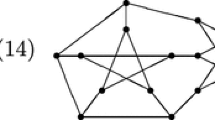Abstract
An immersion of a graph H into a graph G is a one-to-one mapping f: V (H) → V (G) and a collection of edge-disjoint paths in G, one for each edge of H, such that the path P uv corresponding to edge uv has endpoints f(u) and f(v). The immersion is strong if the paths P uv are internally disjoint from f(V (H)). It is proved that for every positive integer Ht, every simple graph of minimum degree at least 200t contains a strong immersion of the complete graph K t . For dense graphs one can say even more. If the graph has order n and has 2cn 2 edges, then there is a strong immersion of the complete graph on at least c 2 n vertices in G in which each path P uv is of length 2. As an application of these results, we resolve a problem raised by Paul Seymour by proving that the line graph of every simple graph with average degree d has a clique minor of order at least cd 3/2, where c>0 is an absolute constant.
For small values of t, 1≤t≤7, every simple graph of minimum degree at least t−1 contains an immersion of K t (Lescure and Meyniel [13], DeVos et al. [6]). We provide a general class of examples showing that this does not hold when t is large.
Similar content being viewed by others
References
F. N. Abu-Khzam and M. A. Langston: Graph coloring and the immersion order, preprint.
N. Alon, M. Krivelevich, B. Sudakov: Turán numbers of bipartite graphs and related Ramsey-type questions, Combin. Probab. Comput. 12 (2003), 477–494.
B. Bollobás, A. Thomason: Proof of a conjecture of Mader, Erdős and Hajnal on topological complete subgraphs, European J. Combin. 19 (1998), 883–887.
H. D. Booth, R. Govindan, M. A. Langston and S. Ramachandramurthis: Sequential and parallel algorithms for K4-immersion testing, J. Algorithms 30 (1999), 344–378.
P. A. Catlin: A bound on the chromatic number of a graph, Discrete Math. 22 (1978), 81–83.
M. DeVos, K. Kawarabayashi, B. Mohar and H. Okamura: Immersing small complete graphs, Ars Math. Contemp. 3 (2010), 139–146.
P. Erdős: Problems and results in graph theory and combinatorial analysis, in: Graph Theory and Related Topics (Proc. Conf. Waterloo, 1977), Academic Press, New York, 1979, 153–163.
M. R. Fellows and M. A. Langston: Nonconstructive tools for proving polynomial-time decidability, J. ACM 35 (1998), 727–738.
J. Fox and B. Sudakov: Dependent random choice, Random Structures and Algorithms 38 (2011), 68–99.
H. Hadwiger: Über eine Klassi kation der Streckenkomplexe, Vierteljahrsschr. Naturforsch. Ges. Zürich 88 (1943), 133–142.
J. Komlós, E. Szemerédi: Topological cliques in graphs. II, Combin. Probab. Comput. 5 (1996), 79–90.
A. Kostochka: Lower bound of the Hadwiger number of graphs by their average degree, Combinatorica 4 (1984), 307–316.
F. Lescure, H. Meyniel: On a problem upon configurations contained in graphs with given chromatic number, Graph theory in memory of G. A. Dirac (Sandbjerg, 1985), 325–331, Ann. Discrete Math. 41, North-Holland, Amsterdam, 1989.
L. Lovász, M. D. Plummer: Matching Theory, AMS Chelsea Publishing, Providence, RI, 2009.
C. St. J. A. Nash-Williams: Edge-disjoint spanning trees of finite graphs, J. London Math. Soc. 36 (1961), 445–450.
N. Robertson and P. D. Seymour: Graph minors. XX. Wagner’s conjecture, J. Combin. Theory Ser. B 92 (2004), 325–357.
N. Robertson and P. D. Seymour: Graph Minors XXIII, Nash-Williams’ immersion conjecture, J. Combin. Theory Ser. B 100 (2010), 181–205.
N. Robertson, P. D. Seymour and R. Thomas: Hadwiger’s conjecture for K 6-free graphs, Combinatorica 13 (1993), 279–361.
P. Seymour: personal communication.
A. Thomason: The extremal function for complete minors, J. Combin. Theory Ser. B 81 (2001), 318–338.
W. T. Tutte: On the problem of decomposing a graph into n connected factors, J. London Math. Soc. 36 (1961), 221–230.
Author information
Authors and Affiliations
Corresponding author
Additional information
Supported in part by an NSERC Discovery Grant (Canada) and a Sloan Fellowship.
Supported by the Center of Excellence — Inst. for Theor. Comp. Sci., Prague, project P202/12/G061 of Czech Science Foundation.
Supported by a Simons Fellowship, NSF grant DMS-1069197, and by an MIT NEC Corporation Award.
Supported by an NSERC Postdoctoral fellowship.
Supported in part by an NSERC Discovery Grant (Canada), by the Canada Research Chair program, and by the Research Grant P1-0297 of ARRS (Slovenia).
Postdoctoral fellowship at Simon Fraser University, Burnaby.
Rights and permissions
About this article
Cite this article
Devos, M., Dvořák, Z., Fox, J. et al. A minimum degree condition forcing complete graph immersion. Combinatorica 34, 279–298 (2014). https://doi.org/10.1007/s00493-014-2806-z
Received:
Published:
Issue Date:
DOI: https://doi.org/10.1007/s00493-014-2806-z




